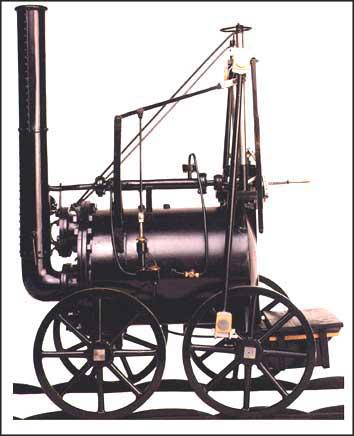Richard Trevithick

Richard Trevithick, was born in Illogan, Cornwall, in 1771. Richard was educated at Camborne School but he was more interested in sport than academic learning. Trevithick was six feet two inches high and was known as the Cornish giant. He was very strong lad and by the age of eighteen he could throw sledge hammers over the tops of engine houses and write his name on a beam six feet from the floor with half a hundredweight hanging from his thumb. Trevithick also had the reputation of being one of the best wrestlers in Cornwall.
Trevithick went to work with his father at Wheal Treasury mine and soon revealed an aptitude for engineering. After making improvements to the Bull Steam Engine, Trevithick was promoted to engineer of the Ding Dong mine at Penzance. While at the Ding Dong mine he developed a successful high-pressure engine that was soon in great demand in Cornwall and South Wales for raising the ore and refuse from mines.
Trevithick also began experimenting with the idea of producing a steam locomotive. At first he concentrating on making a miniature locomotive and by 1796 had produced one that worked. The boiler and engine were in one piece; hot water was put into the boiler and a redhot iron was inserted into a tube underneath; thus causing steam to be raised and the engine set in motion.
Richard Trevithick now attempted to produce a much larger steam road locomotive and on Christmas Eve, 1801, it used it to take seven friends on a short journey. The locomotive's principle features were a cylindrical horizontal boiler and a single horizontal cylinder let into it. The piston, propelled back and forth in the cylinder by pressure of steam, was linked by piston rod and connecting rod to a crankshaft bearing a large flywheel. Trevithick's locomotive became known as the Puffing Devil but it could only go on short journeys as he was unable to find a way of keeping up the steam for any length of time.
Despite these early problems, Trevithick travelled to London where he showed several leading scientists, including Humphrey Davy, what he had invented. James Watt had been considering using this method to power a locomotive but had rejected the idea as too risky. Watt argued that the use of steam at high temperature, would result in dangerous explosions. Trevithick was later to accuse Watt and his partner, Matthew Boulton, of using their influence to persuade Parliament to pass a bill banning his experiments with steam locomotives.
In 1803 a company called Vivian & West, agreed to finance Trevithick's experiments. Richard Trevithick exhibited his new locomotive in London. However, after a couple of days the locomotive encountered serious problems that prevented it pulling a carriage. Vivian & West were disappointed with Trevithick's lack of practical success and they withdrew from the project.
Richard Trevithick soon found another sponsor in Samuel Homfray, the owner of the Penydarren Ironworks in Merthyr Tydfil. In February 1804, Trevithick produced the world's first steam engine to run successfully on rails. The locomotive, with its single vertical cylinder, 8 foot flywheel and long piston-rod, managed to haul ten tons of iron, seventy passengers and five wagons from the ironworks at Penydarren to the Merthyr-Cardiff Canal. During the nine mile journey the Penydarren locomotive reached speeds of nearly five miles an hour. Trevithick's locomotive employed the very important principle of turning the exhaust steam up the chimney, so producing a draft which drew the hot gases from the fire more powerfully through the boiler.
Trevithick's Penydarren locomotive only made three journeys. Each time the seven-ton steam engine broke the cast iron rails. Samuel Homfray came to the conclusion that Trevithick's invention was unlikely to reduce his transport costs and so he decided to abandon the project.
Trevithick was now employed by Christopher Blackett, who owned the Wylam Colliery in Northumberland. A five-mile wooden wagonway had been built in 1748 to take the coal from Wylam to the River Tyne. Blackett wanted a locomotive that would replace the use of horse-drawn coal wagons. The Wylam locomotive was built but weighing five tons, it was too heavy for Blackett's wooden wagonway.
Trevithick returned to Cornwall and after further experiments developed a new locomotive he called Catch Me Who Can. In the summer of 1808 Trevithick erected a circular railway in Euston Square and during the months of July and August people could ride on his locomotive on the payment of one shilling. Trevithick had plenty of volunteers for his locomotive that reached speeds of 12 mph (19 kph) but once again the rails broke and he was forced to bring the experiment to an end.

Without financial backing, Richard Trevithick had to abandon his plans to develop a steam locomotive. Trevithick now found work with a company who paid him to develop a steam dredger to lift waste from the bottom of the Thames. He was paid by results, receiving sixpence for every ton lifted from the river.
Trevithick found it difficult to make money from his steam dredger and in 1816 he accepted an offer to work as an engineer in a silver mine in Peru. After some early difficulties, Trevithick's steam-engines were very successful and he was able to use his profits to acquire his own silver mines. However, in 1826 war broke out and Trevithick was forced to flee and leave behind his steam-engines and silver mines. After a unsuccessful spell in Costa Rica, Trevithick moved to Colombia, where he met Robert Stephenson, who was building a railway in that country. Stephenson generously gave Trevithick the money to pay for his journey back to England.
Although inventors such as George Stephenson argued that Trevithick's early experiments were vital to the development of locomotives, in February 1828, the House of Commons rejected a petition suggesting that he should receive a government pension. Trevithick continued to experiment with new ideas. This included the propulsion of steamboats by means of a spiral wheel at the stern, an improved marine boiler, a new recoil gun-carriage and apparatus for heating apartments. Another scheme was the building of a 1,000 feet cast-iron column to commemorate the 1832 Reform Act.
All these schemes failed to receive financial support and Richard Trevithick died in extreme poverty at the Bull Inn, Dartford, on 22nd April, 1833. As he left no money for his burial, he faced the prospect of a pauper's funeral. However, when a group of local factory workers heard the news, they raised enough money to provide a decent funeral and he was buried in Dartford churchyard.
Primary Sources
(1) The Engineering Magazine (27th March 1868)
Trevithick was the real inventor of the locomotive. He was the first to prove the sufficiency of the adhesion of the wheels on the rails for all purposes of traction on lines of ordinary gradient, the first to make the return flue boiler, the first to use the steam jet in the chimney, and the first to couple all the wheels of the engine.
(2) Richard Trevithick, letter to Davies Gilbert (22 February, 1804)
Yesterday we proceeded on our journey with the engine. We performed the nine miles in four hours and five minutes. We had to remove some large rocks on the way. On our return home one of the small bolts that fastened the axle to the boiler broke, and all the water ran out of the boiler.
Boulton and Watt have strained every nerve to get a bill passed in the House of Commons to stop these engines, saying the lives of the public are endangered.
(3) Richard Trevithick, letter to Davies Gilbert (2nd March, 1804)
We have tried the carriage with twenty-five tons of iron, and found we were more than a match for that weight. The steam is delivered into the chimney above the damper. It makes the draught much stronger by going up the chimney.
(4) In May 1854, Thomas Ellis, an engineer from Tredegar, wrote a letter describing the first journey the Penydarren took in February, 1804.
My father was at Penydarren when the engine was made and tried. Samuel Homfray, proprietor of the Penydarren Iron Works, Merthyr Tydfil, made a bet of 1,000 guineas with Richard Crawshay, of the Cyfarthfa Iron Works, that Trevithick's steam-engine could convey a load of iron from his works to the Navigation House (nine miles distant).
(5) In October 1858, Rees Jones was interviewed by the Mining Journal.
I assisted Mr. Trevithick in the making of his locomotive. She worked very well; but frequently her weight broke the tram-plates. On the third journey she broke a great many of the tram-plates. She was brought back to Penydarren by horses. The engine was never used as a locomotive after this.
